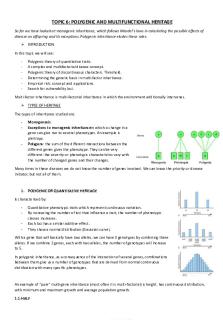Lec 6 - Lecture notes 6 PDF

| Title | Lec 6 - Lecture notes 6 |
|---|---|
| Course | Principles of Macroeconomics |
| Institution | Mount Royal University |
| Pages | 3 |
| File Size | 64.6 KB |
| File Type | |
| Total Downloads | 107 |
| Total Views | 187 |
Summary
Measuring the cost of living...
Description
Econ 1103 Macro
Lec 6 Measuring the cost of living
The consumer price index (CPI) is used to monitor changes in the cost of living over time. When the consumer price index rises, the typical family has to spend more dollars to maintain the same standard of living.
Economists use the term inflationto describe a situation in which the economy’s overall price level is rising. The inflation rateis the percentage change in the price level from the previous period.
The consumer price index (CPI):The overall measure of the cost of the goods and services bought by a typical consumer.
Every month, Statistics Canada computes and reports the CPI. It uses data on the prices of more than 600 different goods and services. To see how these statistics are constructed, a simple economy with two goods is used: hot dogs and hamburgers.
•Five steps to compute the inflation rate: 1.Determine the basket. Which prices are most important to the typical consumer. 2.Find the prices. Of each of the goods and services in the basket for each point in time. 3.Compute the basket’s cost. At different times.
The CPI is not a perfect measure of the cost of living. 1.Commodity substitution bias
2.Introduction of new goods 3.Unmeasured quality change Taken together, these sources of bias cause the CPI to overstate the cost of living by 0.5 percentage points per year according to the Bank of Canada.
Economists and policymakers monitor both the GDP deflator and the CPI to gauge how quickly prices are rising. Usually, these two statistics tell a similar story. Two important differences can cause them to diverge: The GDP deflator reflects prices of goods and services produced domestically. The GDP deflator compares the price of currently produced goods and services with the price of the same goods and services produced during the base year.
The purpose of measuring the overall level of prices in the economy is to permit comparison between dollar figures from different points in time.
Indexation:The automatic correction of a dollar amount for the effects of inflation by law or contract COLA: A COLA automatically raises the wage when the CPI raises.
Interest rates involve comparing amounts of money at different points in time. To fully understand interest rates, knowing how to correct for the effects of inflation is important. Suppose you make a deposit of $1000 in a bank account that pays interest at a rate of 10% per year. After one year, that bank account now contains $1100 (= principal of $1000 + interest of $100). Are you actually wealthier after one year?
Nominal interest rate:The interest rate that is usually reported without a correction for the effects of inflation.
Real interest rate: The interest rate that is corrected for the effects of inflation....
Similar Free PDFs

Lec 6 - Lecture notes 6
- 3 Pages

Part 6 Fin Lec - Lecture notes
- 1 Pages

6 - lec
- 5 Pages

Ch 6 - Lecture notes 6
- 3 Pages

Chapter 6 - Lecture notes 6
- 5 Pages

Module 6 - Lecture notes 6
- 2 Pages

Chapter 6 - Lecture notes 6
- 6 Pages

Chapter 6 - Lecture notes 6
- 9 Pages

Anth101 6 - Lecture notes 6
- 4 Pages

Chapitre 6 - Lecture notes 6
- 2 Pages

Ch 6 - Lecture notes 6
- 4 Pages

Chapter 6 - Lecture notes 6
- 11 Pages

Unit 6 - Lecture notes 6
- 7 Pages

Assignment 6 - Lecture notes 6
- 5 Pages

Experiment 6 - Lecture notes 6
- 4 Pages

CIV1000 - 6 - Lecture notes 6
- 3 Pages
Popular Institutions
- Tinajero National High School - Annex
- Politeknik Caltex Riau
- Yokohama City University
- SGT University
- University of Al-Qadisiyah
- Divine Word College of Vigan
- Techniek College Rotterdam
- Universidade de Santiago
- Universiti Teknologi MARA Cawangan Johor Kampus Pasir Gudang
- Poltekkes Kemenkes Yogyakarta
- Baguio City National High School
- Colegio san marcos
- preparatoria uno
- Centro de Bachillerato Tecnológico Industrial y de Servicios No. 107
- Dalian Maritime University
- Quang Trung Secondary School
- Colegio Tecnológico en Informática
- Corporación Regional de Educación Superior
- Grupo CEDVA
- Dar Al Uloom University
- Centro de Estudios Preuniversitarios de la Universidad Nacional de Ingeniería
- 上智大学
- Aakash International School, Nuna Majara
- San Felipe Neri Catholic School
- Kang Chiao International School - New Taipei City
- Misamis Occidental National High School
- Institución Educativa Escuela Normal Juan Ladrilleros
- Kolehiyo ng Pantukan
- Batanes State College
- Instituto Continental
- Sekolah Menengah Kejuruan Kesehatan Kaltara (Tarakan)
- Colegio de La Inmaculada Concepcion - Cebu